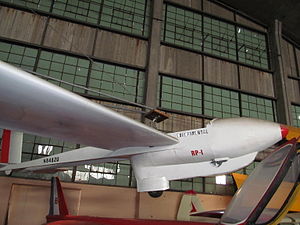| RP-1 | |
|---|---|

| |
| Role | Glider |
| National origin | United States |
| Manufacturer | Rensselaer Polytechnic Institute |
| First flight | 1980 |
| Status | Production completed |
| Number built | one |
The Rensselaer RP-1 (for Rensselaer Polytechnic design 1) is an American low-wing, single-seat, foot-launchable glider that was designed and produced by the Rensselaer Polytechnic Institute of Troy, New York. [1] It first flew in 1980. [2]
Design and development
The RP-1 was partly funded by NASA and was the first aircraft in Rensselaer's Composite Aircraft Program. [1]
The aircraft is of mixed construction, made from composites, Kevlar and PVC foam. Its 37.5 ft (11.4 m) span wing employs a Wortmann FX-63-137 airfoil. The aircraft weighs just 116 lb (53 kg) and was intended to be foot-launched. The landing gear consists of a main skid and dual tail skids. The aircraft achieved a 20:1 glide ratio. Only one was completed. The sole example has been preserved at the Empire State Aerosciences Museum in Schenectady, New York. [1] [3]
Specifications (RP-1)
Data from Sailplane Directory [1]
General characteristics
- Crew: one
- Wingspan: 37 ft 6 in (11.43 m)
- Wing area: 129 sq ft (12.0 m2)
- Aspect ratio: 11:1
- Airfoil: Wortmann FX-63-137
- Empty weight: 116 lb (53 kg)
- Gross weight: 265 lb (120 kg)
Performance
- Maximum glide ratio: 20:1 at 33 mph (53 km/h)
- Rate of sink: 120 ft/min (0.61 m/s)
- Wing loading: 2.05 lb/sq ft (10.0 kg/m2)
See also
Aircraft of comparable role, configuration, and era
Related lists
References
- ^ a b c d Activate Media (2006). "RP-1 Rensselaer". Archived from the original on September 2, 2012. Retrieved August 23, 2011.
- ^ "J2mcL Planeurs - Fiche planeur n°". www.j2mcl-planeurs.net. Retrieved May 21, 2022.
- ^ Lednicer, David (2010). "The Incomplete Guide to Airfoil Usage". Retrieved August 1, 2011.